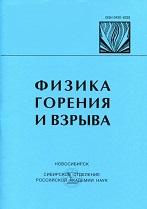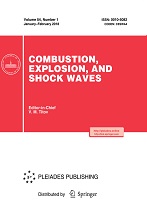|
This article is cited in 9 scientific papers (total in 9 papers)
Chemical processes in the HNF flame
N. E. Ermolina, V. E. Zarkob, H. Keizersc
a Institute of Theoretical and Applied Mechanics, Siberian Division, Russian Academy of Sciences, Novosibirsk, 630090
b Institute of Chemical Kinetics and Combustion, Siberian Division, Russian Academy of Sciences, Novosibirsk, 630090
c TNO Defence, Security and Safety, 2280, AA Rijswijk, Netherlands
Abstract:
Results of modeling the HNF flame structure are presented. From an analysis of literature data on the thermal decomposition and combustion of HNF, it is concluded that the dissociative vaporization of HNF proceeds via the route HNF$_{liq}$ $\to$ (N$_2$H$_4$)$_g$ + (HC(NO$_2$)$_3$)$_g$. The flame structure is modeled using a detailed kinetic mechanism consisting of 47 species and 283 elementary reactions. Its constituents are the decomposition mechanisms of hydrazine (N$_2$H$_4$)$_g$ and trinitromethane (HC(NO$_2$)$_3$)$_g$ (nitroform, NF$_g$). The latter come from the burning surface by dissociative vaporization. The modeling was performed for different routes of NF$_g$ decomposition involving HC(NO$_2$)$_2$, HCNO$_2$, and HC(O)NO$_2$ radicals. The HNF flame structure was calculated for pressures of 0.4, 1, and 5 atm using data on the product composition on the burning surface that correspond to the developed reaction in the condensed phase and are consistent with the chemical composition and enthalpy of formation of HNF. As follows from the calculations, the heat release in the gas-phase reaction of nitroform with hydrazine (and partially with ammonia) leads to a temperature increase in the flame zone adjacent to the burning surface from its value on the surface to $\approx$1300 K. A further increase in the flame temperature is related to the reaction in the H$_2$O/N$_2$/N$_2$O/NH$_3$/NO/NO$_2$/HNO$_2$/CO/CO$_2$/HCNO/HCN mixture. The calculation results are compared with experimental data on the thermal and chemical structure of the HNF flame.
Keywords:
hydrazine nitroformate, flame structure, kinetics, modeling.
Received: 31.10.2005
Citation:
N. E. Ermolin, V. E. Zarko, H. Keizers, “Chemical processes in the HNF flame”, Fizika Goreniya i Vzryva, 42:5 (2006), 20–31; Combustion, Explosion and Shock Waves, 42:5 (2006), 509–520
Linking options:
https://www.mathnet.ru/eng/fgv1624 https://www.mathnet.ru/eng/fgv/v42/i5/p20
|


| Statistics & downloads: |
| Abstract page: | 23 |
|





 Contact us:
Contact us: Terms of Use
Terms of Use
 Registration to the website
Registration to the website Logotypes
Logotypes








 Citation in format
Citation in format 
